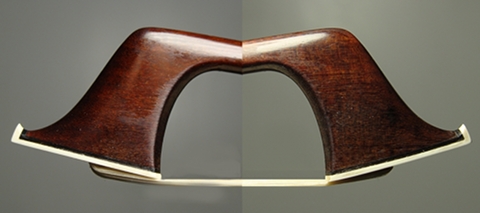CELLO BOW BY DOMINIQUE PECCATTE 1850 CWhen you come to know the bow maker profession, there is a question that keeps emerging: why is the work of one craftsman sometimes valued more, than the work of another craftsman of a similar level - or even valued more than a work of a greater level? “The bumble bee is too heavy to fly, but no-one told the bee”. Cello Bow By Dominique Peccatte 1850 c (click to enlarge) This statement has the purpose to bring laughter, therefore it doesn't mention that to make a true analysis you have to considerate the frequency of the wings going up and down. Same story with this object. This stick has definitely been extremely difficult to work, so much that any craftsman would resent it. Anyone but Domenique Peccatte. Just like the bow I discussed last week, this bow was made sometime during the second half of the 1840'ies. Possibly it dates back to the post Parisian period. In 1847, Peccatte and his brother Francois returned to live together in their childhood home in Mirecourt. Two years, later Francois moved to Paris. Perhaps because of his brother's irrepressible sympathy and overwhelming generosity. Perhaps because he didn't wish to end up killing him. Dominique may have been everything but sympathetic, however he sure knew how to use a planer. Just look how he has been able to bring out the mirroring of the medullary rays on the right side of the head. What surprises even more than the beauty of the bow, is it's weight. The frog is made of gold, and in this case it is a copy. I was sure that the original would have been made of gold as well, but I was wrong. Master Meneses, who has the original frog, could tell me that it was made of silver. It is not unusual to increase the weight of a bow, by means of the fittings, but you would only do so on a low density wood bow, and this isn't the case. Fitted with a gold frog and a three part button, the bow should weigh at least 86/87 g. Even so, the object I had in my hands seemed strangely light weight. The scales showed....82 g. When Dominique made this bow, he finished at no more than 77 g. But more surprising is its capability to maintain the curve and sustain the force of Master Meneses' arm. Unlike many other craftsmen, Pecatte had the good fortune to have a great teacher. This teacher, Jean Pierre Marie Persoit, is the bow maker whose curves are among the best preserved, and his great school has produced some of the most excellent progeny of bow makers: Pierre Simon and Joseph Henry, both pupils of Peccatte. With this stick, Peccatte demonstrates the greatness of the school and its mastery. As taught by Persoit, he kept on planing away wood until he obtained enough flexibility; the thinness indicates that he was quite a master. A small parenthesis: the ivory tip, which isn't the original and furthermore not exactly a beauty, is made of bone. I believe a bow like this deserves a piece made in ivory. I hope the Master will have it replaced because it spoils the beauty of the entire bow. Speaking once again about the stick, one does from time to time come across antique light weighted bows made of dense wood, though usually the curves in these objects are disastrous and unplayable at times. This curve is intact and sustains the force of even a hand. This is why some craftsmen are valued more than others. Only a few have been able to make something like this. Beyond sound and strength they are a real academy of construction. In an absurd way, these bows are more useful in our work as craftsmen than they are to the musicians, and that is because we can improve our work by studying these objects. The frog is a copy in the original style. It is perfect and probably made by the same craftsman who made the one on the bow discussed last week. This time he allowed himself to be inspired solely by Peccatte, maintaining full thickness on the cheeks, though he emphasizes the entrance at the lower part of the throat slightly echoing Simon. Specifications and measurements: Once again, I thank Master Meneses, for letting me photograph his splendid bows in order to show them to you. To read more about this topic: PECCATTE, THE SILENT REBELLION PIERRE SIMON; THE NICE PECCATTE JOSEPH HENRY; L'ENFANT PRODIGE So long, Paolo
|
   |






